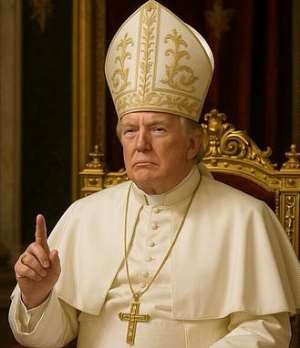
In a media landscape accustomed to spectacle, few can match Donald Trump’s flair for provocation and performance. Yet when he posted an AI-generated image of himself clad in full papal regalia—a golden mitre, a richly embroidered cope, and a serene expression with a finger up befitting a spiritual monarch- the world took more than a second look. It wasn’t just a meme; it was interpreted by some as a harbinger. Days later, the College of Cardinals made a historic decision, electing an American as pope—Leo XIV.
For many, the timing was uncanny. Trump’s critics dismissed it as another ego-driven antic, while his supporters proclaimed it prophetic, even divine. Social media buzzed with speculation: was Trump signalling a spiritual transformation? Was it a coded message to conservative Catholics? Or, more radically, did the post somehow influence the cardinals’ decision in the conclave?
Such claims, however sensational, do not withstand scrutiny. The election of a pope is among the most secretive and spiritually guided processes in the world. The College of Cardinals operates in extra omnes—complete isolation—shielded from politics, media, and digital noise. The idea that a social media post, however viral, could penetrate the sacred confines of the Sistine Chapel and steer the minds of seasoned cardinals is not only implausible, but also a grave misunderstanding of how the Church discerns its shepherd.
Pope Leo XIV, though American by birth, was not a political appointee nor a product of populist sentiment. His rise through the ranks of the Church had been marked by deep theological depth, pastoral sensitivity, and global experience. He had served in South America, Asia, and Europe before returning to the U.S., where his quiet strength and deep orthodoxy made him respected across ideological divides. He was, in every sense, a servant.
Those suggesting Trump’s AI image “paved the way” for Leo XIV confuse symbolism with causality. What the post did capture, perhaps unintentionally, was the West’s hunger for spiritual authority amid political chaos. Trump, a master of tapping into the collective subconscious, may have posted it as a cultural commentary or a satire of modern celebrity. Yet, in a world tired of blurred lines between entertainment, power, and religion, it was taken seriously by many who yearn for a merging of moral clarity with assertive leadership.
In truth, the Pope is not a president, and the Church is not a democracy. The cardinals who elected Leo XIV did so prayerfully, guided not by polls or posts but by the Holy Spirit. That he is American is incidental, not calculated. Trump’s image may have been a meme; Leo’s election was a moment of providence. To confuse the two is to trivialise both faith and leadership.
What we are witnessing, then, is not a Trumpian takeover of the Vatican but a convergence of a world longing for stability, order, and meaning.
Leo XIV may symbolise a moral resurgence, and Trump may continue to harness religious symbolism for political effect, but make no mistake: one wears the mitre, and the other wore it digitally. Only one leads the universal Church – Pope Leo XIV.


